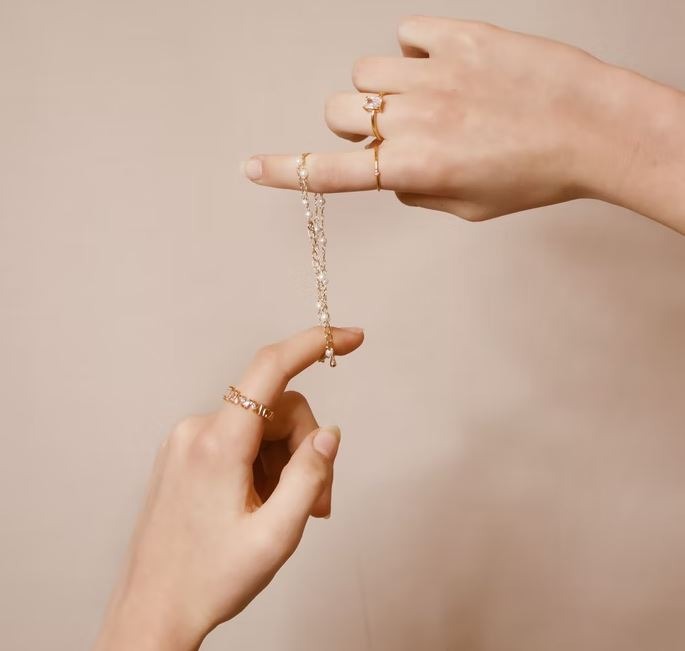Allergies to jewelry are common, and a large number of people are allergic to various metals, such as precious metals. And if you’re a jewelry collector, especially if you have sensitive skin, it means you will have to be extra cautious about the jewelry you choose.
When it comes to metal allergies, it’s common to be told to wear higher karat gold jewelry, but what if even the best of higher karat gold pieces can cause reactions?
Metallic gold is prized for its low reactivity and electrochemical nobility. As a result, it is commonly regarded as a non-allergenic metal.
Further to that, skin contact with gold can cause allergic reactions in some people. The number of people who have a reaction to gold is unknown. In a 2001 study, about 9.5 percent of 4,101 people tested positive for a gold allergy, with more women than men testing positive.
To be clear, a reaction to gold is not always caused by the gold itself, but by metals present in the gold, such as nickel. Nickel is found in trace amounts in some gold. Contact with these types of gold may end up causing a skin reaction if you have a metal or nickel allergy.
The Symptoms of Gold Allergy
A gold allergy has symptoms that are similar to those of other allergies. Although everyone’s body reacts differently to allergens, common symptoms include:
- Swelling
- Rash
- Redness
- Itching
- Peeling
- Dark spots
- Blistering
The symptoms can be mild to severe. They can appear soon after coming into contact with gold or after prolonged exposure. Wearing a gold ring can cause redness, discoloration, and itchiness on your finger. After wearing gold earrings or a gold necklace, you may experience symptoms on your ear or around your neck. Because it is difficult to tell the difference between a gold allergy and other allergies, you might mistake your symptoms for eczema or another type of contact dermatitis. If you have a gold allergy, you will most likely have the same reaction every time you come into contact with gold. On the other hand, a gold allergy has no known cause, but symptoms appear when your immune system becomes sensitive to the metal. You are more likely to develop a gold allergy if you are allergic to other metals or have a family history of nickel or metal allergies. It is also possible that other metals mixed in with gold jewelry or other gold items are causing your reaction. Nickel is one of the most common metal allergens, and it is frequently alloyed with gold.
The Nickel Allergy Hidden in Gold
But keep in mind that not all gold contains nickel traces. If you are allergic to nickel, you may only experience a reaction when going to wear certain types of gold. The less nickel a piece of jewelry contains, the more pure gold it contains. As a result, you may not react to 24 karat gold, which is pure gold and contains 99.9% gold. Nickel and other metals make up less than 0.1 percent of the total. Similarly, with 18 karat gold, which is 75 percent gold, your chances of a reaction may be reduced. However, if you wear gold that is only 12 or 9 carats, you may be more likely to react because it contains a significant amount of nickel or another metal. White gold, on the other hand, is more likely to cause an allergic reaction. Although yellow gold can consist of nickel, it is usually alloyed with silver or copper. White gold seems to be mostly nickel alloyed.
The Treatment for Gold Allergy
If you experience itching, swelling, redness, or blistering as a result of wearing gold jewelry, the best treatment is to apply an over-the-counter topical corticosteroid cream. In addition, keep your skin hydrated and apply a cool compress to reduce itching. Consult your doctor if you have a severe reaction, as you may require a relatively strong medication. You may also want to avoid wearing the jewelry altogether to prevent future allergic reactions.
What To Look For In A Jewelry
Wearing jewelry that does not irritate your skin is the best way to avoid a reaction. You can either avoid wearing gold jewelry altogether or limit yourself to 18 or 24 karat gold. However, because the underlying cause is frequently a nickel allergy, you will most likely need to avoid wearing other types of jewelry as well. Costume jewelry is included. Look for hypoallergenic or nickel-free jewelry, just like you would for hypoallergenic makeup. Wearing stainless steel or titanium can also help you avoid a skin reaction. Another tip is to replace metal watchbands with cloth, plastic, or leather ones. Wear gloves if your work requires contact with nickel or gold to reduce the risk of a reaction. Bear in mind that nickel is present in many everyday items and can cause a reaction when skin-to-skin contact occurs. The Eyeglass frames, tools, keys, coins, belt buckles, razors, and even bra hooks are among these items. Consider replacing your metal eyeglass frames with plastic or titanium frames, for example.
How is Gold Allergy Diagnosed
Consult your doctor if you suspect you have a gold or nickel allergy. Your doctor will examine your skin and inquire about your medical and family histories. Some doctors can make a diagnosis based on your skin’s appearance. However, you will almost certainly be referred to an allergist or dermatologist for additional testing. Patch testing for jewelry is similar to patch testing for makeup. A patch test can be used by these experts to confirm or rule out a nickel or metal allergy. This entails exposing a small patch of skin to the allergen and checking for a reaction.
In conclusion, there is no treatment for a gold or nickel allergy. However, you can alleviate symptoms by avoiding metal-containing jewelry. It also helps to become familiar with other gold or nickel-containing items and avoid contact with them.


